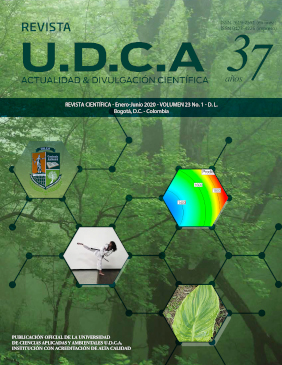Obtención de un colorante a partir de corteza de maracuyá con el uso de técnicas convencionales de extracción
Obtaining a dye from passion fruit cortex with the use of conventional extraction techniques
Contenido principal del artículo
Resumen
El maracuyá es un fruto tropical que se cultiva primordialmente para la obtención de pulpa, siendo la corteza su principal subproducto que carece, en la actualidad, de interés industrial; sin embargo, con el fin de diversificar los derivados provenientes de la producción de maracuyá, se ha demostrado que la corteza contiene carotenoides, dentro de los que se destaca el β-caroteno y la luteína, que podrían ser utilizados en alimentos, debido a su poder antioxidante e, incluso, como colorante natural alternativo. Por lo anterior, el objetivo de este trabajo fue obtener un extracto rico en carotenoides a partir de su corteza; para ello, se evaluó la extracción con etanol, mediante tres técnicas: inmersión, baño termostático y soxhlet. El mayor rendimiento, se obtuvo con el método soxhlet; para esta técnica, se estudió el efecto de la concentración de etanol (entre 80% y 90% v/v), la proporción solvente-materia prima (con relaciones entre 40:1 y 50:1) y el tiempo (definido entre 90 y 150 minutos). Los resultados, se analizaron mediante modelo de superficie de respuesta, obteniendo el mayor rendimiento con etanol al 90%, utilizando 50mL/g corteza y 150 minutos de operación. A estas condiciones, el rendimiento de extracción fue de 2208,53µg β-caroteno/100g muestra. Por último, se determinó la diferencia de color entre el extracto óptimo y una solución de tartrazina, evidenciando una diferencia de color de 3,07 unidades cieLAB, lo cual, muestra que el producto de lixiviación de la corteza de maracuyá tiene potencial para su uso como aditivo alimentario, reemplazando colorantes sintéticos, como la tartrazina.
Palabras clave:
Descargas
Datos de publicación
Perfil evaluadores/as N/D
Declaraciones de autoría
- Sociedad académica
- Universidad de Ciencias Aplicadas UDCA
- Editorial
- Universidad de Ciencias Aplicadas y Ambientales U.D.C.A
Detalles del artículo
Referencias (VER)
AIBANA, O.; FRANKE, M.F.; HUANG, C.C.; GALEA, J.T.; CALDERON, R.; ZHANG, Z.; BECERRA, M.C.; SMITH, E.R.; RONNENBERG, A.G.; CONTRERAS, C.; YATACO, R.; LECCA, L.; MURRAY, M.B. 2017. Impact of Vitamin A and Carotenoids on the Risk of Tuberculosis Progression. Clin. Infect. Dis. 65(6):900-909. https://doi.org/10.1093/cid/cix476
ASSOCIATION OF OFFICIAL ANALYTICAL CHEMISTS -AOAC-. 1995. 942.15 Acidity (Titratable) of fruit products. 16th ed Official methods of analysis of AOAC International.. AOAC International (Arlington).
BARBOSA DE OLIVEIRA, A.; DE ALMEIDA LOPES, M.M.; HERBSTER MOURA, C.F.; DE SIQUEIRA OLIVEIRA, L.; OLIVEIRA DE SOUZA, K.; GOMES FILHO, E.; URBAN, L.; ALCÂNTARA DE MIRANDA, M. R. 2017. Effects of organic vs. conventional farming systems on quality and antioxidant metabolism of passion fruit during maturation. Scientia Horticulturae. 222:84-89. https://doi.org/10.1016/j.scienta.2017.05.021
BATADA, A.; JACOBSON, M.F. 2016. Prevalence of Artificial Food Colors in Grocery Store Products Marketed to Children. Clin. Pediat. 55(12):1113-1119. https://doi.org/10.1177/0009922816651621
BENMEZIANE, A.; BOULEKBACHE-MAKHLOUF, L.; MAPELLI-BRAHM, P.; KHALED KHODJA, N.; REMINI, H.; MADANI, K.; MELÉNDEZ-MARTÍNEZ, A.J. 2018, Extraction of carotenoids from cantaloupe waste and determination of its mineral composition. Food Res. Int. 111:391-398. https://doi.org/10.1016/j.foodres.2018.05.044
BETIM CAZARIN, C.B.; DA SILVA, J.K.; COLOMEU, T.C.; DE LIMA ZOLLNER, R.; MARÓSTICA JUNIOR, M.R. 2014. Capacidade antioxidante e composição química da casca de maracujá (Passiflora edulis). Cienc. Rural 44(9):1699-1704. https://doi.org/10.1590/0103-8478cr20131437
BHATT, D.; VYAS, K.; SINGH, S.; JOHN, P.J.; SONI, I. 2018. Tartrazine induced neurobiochemical alterations in rat brain sub-regions. Food Chem. Toxicol. 113:322-327. https://doi.org/10.1016/j.fct.2018.02.011
BRENNAN, J.G.; GRANDISON, A.S.; LEWIS, M.J. 2006. Separations in food processing. En: Brennan J.G. (Ed.). Food Processing Handbook. 3st Ed. Wiley-vch verlag GmbH & Co. KGaA (Weinheim). p.455-464.
DE ANDRADE, M.; CHARALAMPOPOULOS, D.; CHATZIFRAGKOU, A. 2018. Optimisation and modelling of supercritical CO2 extraction process of carotenoids from carrot peels. J. Supercrit. Fluid. 133:94-102. https://doi.org/10.1016/j.supflu.2017.09.028
DE OLIVEIRA, C.F.; GIORDANI, D.; GURAK, P.D.; CLADERA-OLIVERA, F.; MARCZAK, L.D.F. 2015. Extraction of pectin from passion fruit peel using moderate electric field and conventional heating extraction methods. Innov. Food Sci. Emerg. Technol. 29:201-208. https://doi.org/10.1016/j.ifset.2015.02.005
DE OLIVEIRA, G.A.; DE CASTILHOS, F.; RENARD, C.M.-G.; BUREAU, S. 2014. Comparison of NIR and MIR spectroscopic methods for determination of individual sugars, organic acids and carotenoids in passion fruit. Food Res. Int. 60:154-162. https://doi.org/10.1016/j.foodres.2013.10.051
DO ESPÍRITO SANTO, A.P.; PEREGO, P.; CONVERTI, A.; OLIVEIRA, M. N. 2012. Influence of milk type and addition of passion fruit peel powder on fermentation kinetics, texture profile and bacterial viability in probiotic yoghurts. LWT-Food Sci. Technol. 47(2):393-399. https://doi.org/10.1016/j.lwt.2012.01.038
DOS REIS, L.C.R.; FACCO, E.M.P.; SALVADOR, M.; FLÔRES, S.H.; DE OLIVEIRA RIOS, A. 2018. Antioxidant potential and physicochemical characterization of yellow, purple and orange passion fruit. J. Food Sci. echnol. 55(7):2679-2691. https://doi.org/10.1007/s13197-018-3190-2
ELIK, A.; YANIK, D.K.; GÖĞÜŞ, F. 2020. Microwave-assisted extraction of carotenoids from carrot juice processing waste using flaxseed oil as a solvent. LWT-Food Sci. Technol. 123:109100. https://doi.org/10.1016/j.lwt.2020.109100
GU, Z.; DEMING, C.; YONGBIN, H.; ZHIGANG, C.; FEIRONG, G. 2008. Optimization of carotenoids extraction from Rhodobacter sphaeroides. LWT-Food Sci. Technol. 41(6):1082-1088. https://doi.org/10.1016/j.lwt.2007.07.005
HERNÁNDEZ-SANTOS, B.; DE LOS ÁNGELES VIVAR-VERA, M.; RODRÍGUEZ-MIRANDA, J.; HERMAN-LARA, E.; TORRUCO-UCO, J.G.; ACEVEDO-VENDRELL, O.; MARTÍNEZ-SÁNCHEZ, C.E. 2015. Dietary fibre and antioxidant compounds in passion fruit (Passiflora edulis f. flavicarpa) peel and depectinised peel waste. Int. J. Food Sci. Technol. 50(1):268-274. https://doi.org/10.1111/ijfs.12647
HERRERA-RAMIREZ, J.; MENESES-MARENTES, N.; TARAZONA-DÍAZ, M.P. 2019. Optimizing the extraction of anthocyanins from purple passion fruit peel using response surface methodology. J. Food Meas. Charact. https://doi.org/10.1007/s11694-019-00280-8
JUÁREZ, M.C.; ECHÁVARRI, J.F.; NEGUERUELA, A.I. 1997. A proposal for a method to measure the colour of red wines by measuring transmittance at three wavelengths. Food Sci. Technol. Int. 3(3):189-193. https://doi.org/10.1177/108201329700300306
KHAZAEI, K.M.; JAFARI, S.M.; GHORBANI, M.; KAKHKI, A.H.; SARFARAZI, M. 2016. Optimization of Anthocyanin Extraction from Saffron Petals with Response Surface Methodology. Food Anal. Methods. 9(7):1993-2001. https://doi.org/10.1007/s12161-015-0375-4
KIM, B.; PARK, B. 2018. Saffron carotenoids inhibit STAT3 activation and promote apoptotic progression in IL-6-stimulated liver cancer cells. Oncol. Rep. 39(4):1883-1891. https://doi.org/10.3892/or.2018.6232
KULKARNI, S.G.; VIJAYANAND, P. 2010. Effect of extraction conditions on the quality characteristics of pectin from passion fruit peel (Passiflora edulis f. flavicarpa L.). LWT-Food Sci. Technol. 43(7):1026-1031. https://doi.org/10.1016/j.lwt.2009.11.006
LEÃO, K.M.M.; SAMPAIO, K.L.; PAGANI, A.A.C.; DA SILVA, M.A.A.P. 2014. Odor potency, aroma profile and volatiles composition of cold pressed oil from industrial passion fruit residues. Ind. Crop. Prod. 58:280-286. https://doi.org/10.1016/j.indcrop.2014.04.032
MCCANN, D.; BARRETT, A.; COOPER, A.; CRUMPLER, D.; DALEN, L.; GRIMSHAW, K.; KITCHIN, E.; LOK, K.; PORTEOUS, L.; PRINCE, E.; SONUGA-BARKE, E.; WARNER, J.O.; STEVENSON, J. 2007. Food additives and hyperactive behaviour in 3-year-old and 8/9-year-old children in the community: a randomised, double-blinded, placebo-controlled trial. Lancet 370(9598):1560-1567. https://doi.org/10.1016/S0140-6736(07)61306-3
MOJICA, L.; BERHOW, M.; GONZALEZ DE MEJIA, E. 2017. Black bean anthocyanin-rich extracts as food colorants: Physicochemical stability and antidiabetes potential. Food Chem. 229:628-639. https://doi.org/10.1016/j.foodchem.2017.02.124
MYERS, R.H.; MONTGOMERY, D.C. 2002. Building Empirical Model. En: Myers R.H.; Montgomery, D.C. (Eds.). Response Surface Methodology Process and Product Optimization Using Designed Experiments. 2nd Ed. Wiley-Interscience (New York). p.17-74.
NAGATA, M.; YAMASHITA, I. 1992. Simple Method for Simultaneous Determination of Chlorophyll and Carotenoids in Tomato Fruit. J. Japan Soc. Food Sci. 39(10):925-928. https://doi.org/10.3136/nskkk1962.39.925
NASCIMENTO, T.A.; CALADO, V.; CARVALHO, C.W.P. 2012. Development and characterization of flexible film based on starch and passion fruit mesocarp flour with nanoparticles. Food Res. Int. 49(1):588-595. https://doi.org/10.1016/j.foodres.2012.07.051
RODRIGUEZ-AMAYA, D.B. 2012. Passion Fruit. En: Siddiq, M. (Ed.). Tropical and Subtropical Fruits: Postharvest, Physiology, Processing and Packaging. Ed. Wiley-Blackwell (Oxford). p.324-329. https://doi.org/10.1002/9781118324097
SAHIN, S.; SUMMU, S.G. 2009. Propiedades elecromagnéticas. En: Sahin, S.; Summu, S. (Eds.). Propiedades físicas de los alimentos. Ed. Acribia S.A. (Zaragoza). p.190-203.
SAINI, R.K.; KEUM, Y.-S. 2018. Carotenoid extraction methods: A review of recent developments. Food Chem. 240:90-103. https://doi.org/10.1016/j.foodchem.2017.07.099
SÁNCHEZ-CAMARGO, A. DEL P.; GUTIÉRREZ, L.F.; VARGAS, S.M.; MARTINEZ-CORREA, H.A.; PARADA-ALFONSO, F.; NARVÁEZ-CUENCA, C.E. 2019. Valorisation of mango peel: Proximate composition, supercritical fluid extraction of carotenoids, and application as an antioxidant additive for an edible oil. J. Supercrit. Fluid. 152:104574. https://doi.org/10.1016/j.supflu.2019.104574
SANTOS, E.; ANDRADE, R.; GOUVEIA, E. 2017. Utilization of the pectin and pulp of the passion fruit from Caatinga as probiotic food carriers. Food Biosci. 20:56-61. https://doi.org/10.1016/j.fbio.2017.08.005
SIGURDSON, G.T.; TANG, P.; GIUSTI, M.M. 2017. Natural colorants: food colorants from natural sources. Annu. Rev. Food Sci. Technol. 8(1):261-280. https://doi.org/10.1146/annurev-food-030216-025923
TARAZONA-DÍAZ, M.P.; AGUAYO, E. 2013. Influence of acidification, pasteurization, centrifugation and storage time and temperature on watermelon juice quality. J. Sci Food Agric. 93(15):3863-3869. https://doi.org/10.1002/jsfa.6332
VIANNA-SILVA, T.; LIMA, R.V.; DE AZEVEDO, I.G.; ROSA, R.C.C.; DE SOUZA, M.S.; DE OLIVEIRA, J.G. 2010. Determinação da maturidade fisiológica de frutos de maracujazeiro-amarelo colhidos na região norte do estado do Rio de Janeiro, Brasil. Rev. Bras. Frutic. 32(1):57-66. https://doi.org/10.1590/s0100-29452010005000012
WIJERATNAM, S.W. 2016. Passion Fruit. En: Caballero, B.; Finglas, P.M.; Toldrá, F. (Eds.). Encyclopedia of Food and Health. Ed. Elsevier (Oxford). p.230-234. https://doi.org/10.1016/b978-0-12-384947-2.00521-3
WU, J.; CHO, E.; WILLETT, W.C.; SASTRY, S.M.; SCHAUMBERG, D.A. 2015. Intakes of lutein, zeaxanthin, and other carotenoids and age-related macular degeneration during 2 decades of prospective follow-up. JAMA Ophthalmol. 133(12):1415-1424. https://doi.org/10.1001/jamaophthalmol.2015.3590







